Baldur’s Gate 3 presents you with numerous options and quests that’ll surprise and, at times, frustrate you. But, before you can progress further, you might want to know a few tips for the start of your journey. Here’s our beginner’s guide to help you out.
Note: For more information, check out our Baldur’s Gate 3 guides and features hub. Likewise, be reminded that this guide is intended for the game’s Early Access stage. Some information and mechanics might change in due course.
Baldur’s Gate 3: Beginner’s guide and starter tips
Familiarize yourself with character creation, but don’t feel too pressured
Even though Baldur’s Gate 3 is in its Early Access stage, it already has countless options when you’re trying to create a character. Yes, it does pay well to become somewhat familiar with these concepts. It’s a lot to take in, but my advice, especially if you’re a newcomer to the series (or even the genre) is to take a deep breath, relax, and don’t let it overwhelm you.
Trying to find the perfect combinations and ideal starter picks would be too much assuming you’re only on your first character. Think of this as your time to experiment and learn the game. Since only the first act of Baldur’s Gate 3 is available at the moment, you might want to reroll and choose more suitable options in subsequent playthroughs.
Note: You can learn more in our character creation guide.
Skills, proficiencies, attributes, and classes
During character creation, you’ll encounter terms like “skills,” “proficiency,” and “abilities.” For skills, think of these as your expertise in any given area that governs interactions in the game. For instance, if there’s a moment when your character talks about powerful magic, your proficiency in Arcana might apply. Conversely, if there’s a choice to pickpocket someone, then the Sleight of Hand skill and your proficiency in it are what you’ll use.
Just to be clear, although you gain bonuses to particular skills or proficiencies based on your chosen background in Baldur’s Gate 3, some of these might get invalidated depending on the class. For instance, the Acolyte background gives you proficiencies in both the Insight and Religion skills which are great for Wizards (both skills will be used in future interactions). However, other classes might only have one skill active while the other one won’t be used at all.
As for proficiency, it determines your character’s capabilities in battle. For example, a class might have “Heavy Armor Proficiency,” and that just means you get to use the sturdiest armor pieces in the game without being penalized. The same also applies to weapon types that your character’s an expert in.
As for the attributes or stats, these are called “abilities” in Baldur’s Gate 3. The six ones to take note of are:
- Strength (STR) – hit chance/attack roll and damage with STR-based weapons, jump distance, and carry weight.
- Dexterity (DEX) – hit chance/attack roll and damage with DEX-based weapons, initiative (turn order in battle), and armor class (the chance that an enemy would hit you).
- Constitution (CON) – Your health/HP and any bonus HP you earn from level-ups.
- Intelligence (INT) – Primarily used by Wizards as their spellcasting stat (the chance that spells would hit); usually considered as “dump stat” for other classes. A “dump stat” is one that you completely ignore in favor of other prioritized stats; you only “dump” points into it once all other options have been exhausted.
- Wisdom – Primarily used by Rangers, Clerics, and Druids for their spellcasting stat; the Druid class isn’t included in Early Access yet.
- Charisma – Primarily used by Sorcerers, Paladins, and Bards for their spellcasting stat; the Paladin and Bard classes aren’t included in Early Access yet.
Note: Ideally, you should follow the primary stat for a particular class and then put points into secondary ones while ignoring that class’ “dump stat.” You can learn more about ideal skills, proficiencies, and attribute/stat allocations in our class guides. We have class guides for the Cleric, Fighter, Ranger, Rogue, Warlock, and Wizard.
What’s all this 1d, 2d, 3d, 4d nonsense? Do I need to play D&D just to understand everything?
Don’t fret. You’re not required to play Dungeons & Dragons, or even the previous Baldur’s Gate games, to understand the mechanics of Baldur’s Gate 3. Now, regarding the “1d/2d” concept, these refer to dice rolls and, in relation to combat, the damage that you deal.
A value before the “d” represents the number of dice being rolled to determine an action’s success. The number after that, meanwhile, denotes the “sides of the die” — aka. the maximum value that can be rolled. Here are some examples:
- 1d10 – It means one die is being rolled, and the maximum possible value you can get is 10.
- 1d20 – One die is being rolled, and the maximum possible value is 20.
- 2d6 – Two dice are being rolled and each one has a maximum possible value of six.
Let’s say we apply this to combat in Baldur’s Gate 3 and you see a spell that says “1d10 Force damage.” It simply means that this spell can potentially do a minimum of one point of damage and a maximum of 10 (if it hits a target).
In summation, just think of Baldur’s Gate 3 as any traditional RPG you’ve played before. The difference is that skills and spells aren’t written down as “deals 1-10 damage.” Instead, they’re usually written down as “1d10 damage.”
Now, this concept is also applied when it comes to skill checks. Remember the ones I mentioned like Arcana or Sleight of Hand, as well as any of the six governing attributes? From time to time, you’ll be presented with these instances and dilemmas, most notably during conversations and cutscenes.
These usually have a “1d20 roll” and a value required for you to pass it. So, if the requirement is 10 and you roll equal to or above that (up to 20), you’ll pass the skill check successfully. If you get a result below 10, then the skill check fails and you have to accept the consequences.
Controls and keybinds
Fairly early on in Baldur’s Gate 3‘s campaign, you’ll want to recheck your keybinds. The reason for this is that the default binds are somewhat wonky. For instance, you should make sure that camera rotation is done via the Q and E keys since you’re using the WASD keys to pan and move the camera anyway.
Next up, Left-Alt is used to highlight characters, including corpses. This lets you easily see which ones you could loot. The problem, though, is that it doesn’t highlight certain objects (i.e., barrels), so make note of that as you’re exploring.
Lastly, there’s the Left-Ctrl key. This lets your character switch to an aggressive stance where your next left-click action attacks or destroys a target. Don’t accidentally hold this and click on a neutral NPC, or you might be in for an unnecessary fight.
Companions and pals
You can have up to four companions in your party in Baldur’s Gate 3. You’ll have an AI-controlled companion during the prologue (Lae’zel). However, you’ll meet more buddies during the first chapter. Who knows? You might even encounter Lae’zel once more.
Companions have their likes and dislikes and, depending on your actions, you could gain their trust. Certain dialogue options might also turn them off, or would make you dismiss them outright.
Ideally, however, you should bring companions that complement your main character’s playstyle and capabilities. For instance, if I’m using a Warlock, I’ll keep Shadowheart with me at all times. She’s a Cleric which means she’s got healing spells, and she can help shield me during melee engagements.
Saving, checking your minimap, and taking a short or long rest
Although Baldur’s Gate 3 has an autosave system, you should still try to manually save as often as possible. This is due to encounters that can happen without any warning, or, rather, that warning might come from a minimap icon. As you can see below, there’s a red pip on the minimap signifying a nearby hostile. By advancing further, I ended up in a battle (and the autosave didn’t kick in).
Note: Yellow pips indicate neutral creatures/NPCs.
As for taking a short rest, it’s actually a teensy tiny button at the right-hand side of the minimap (you can see the small icon of an eye highlighted in blue in the image above). Taking a short rest replenishes the HP of characters and some spells. You may only take a short rest in between every long rest.
That long rest is actually part of your camp, the other button (campfire icon) highlighted in blue. The camp ends the day and is useful for various functions such as swapping out party members. Likewise, taking a long rest while at camp greatly heals you, restores all possible abilities/spells, and removes negative effects from previous bouts.
Baldur’s Gate 3 is available as part of Steam’s Early Access program. For more information, check out our guides and features hub.

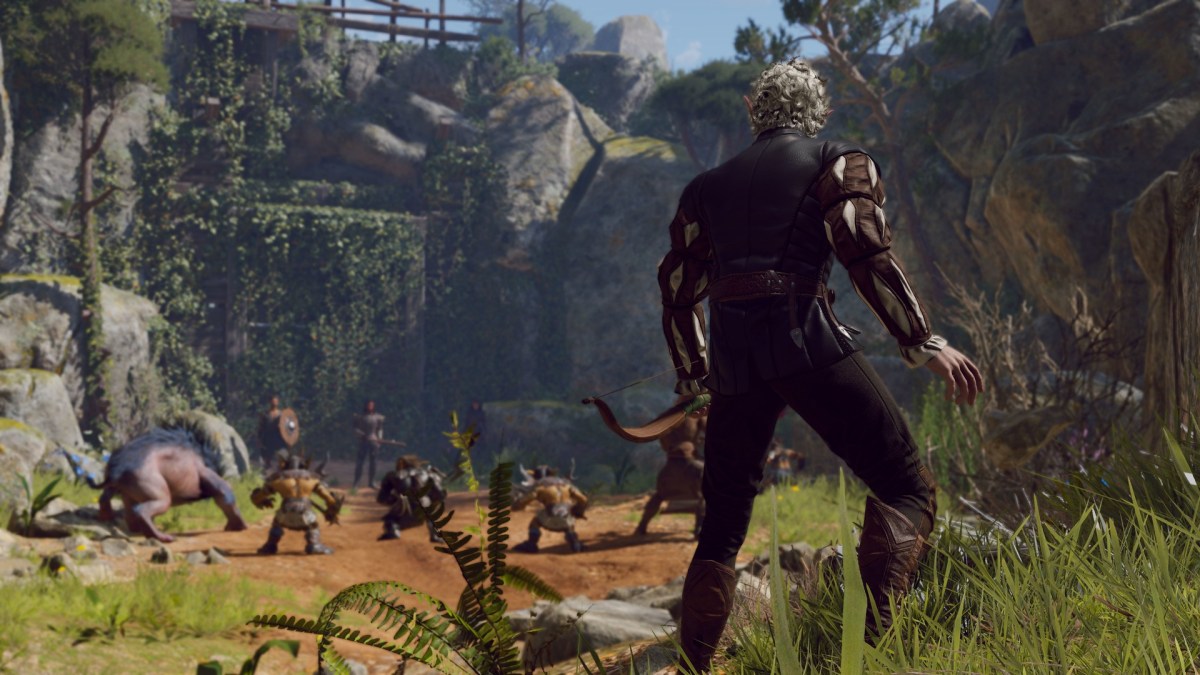
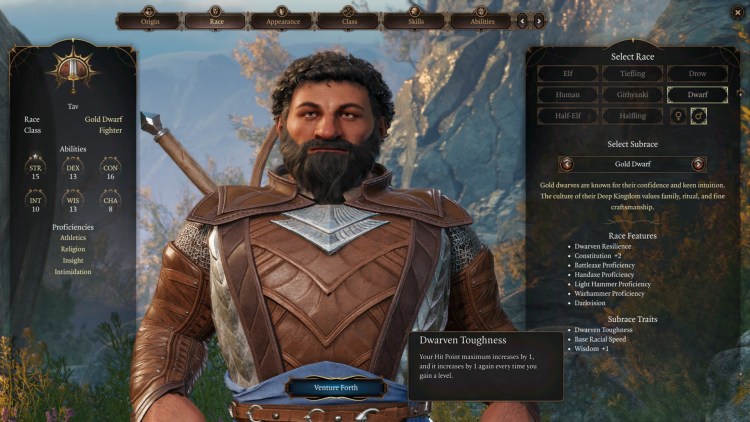
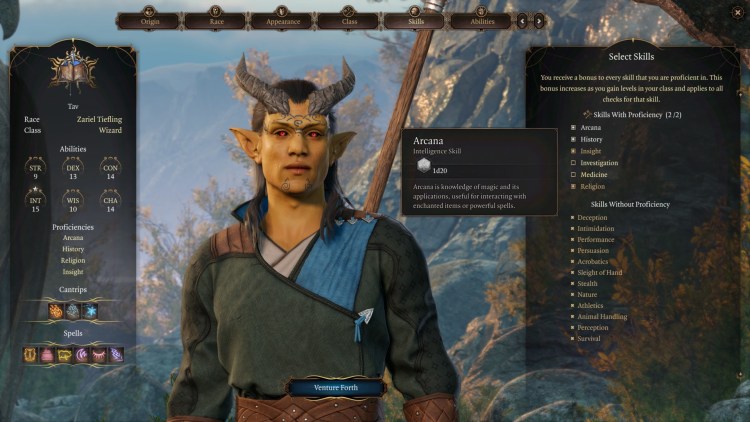
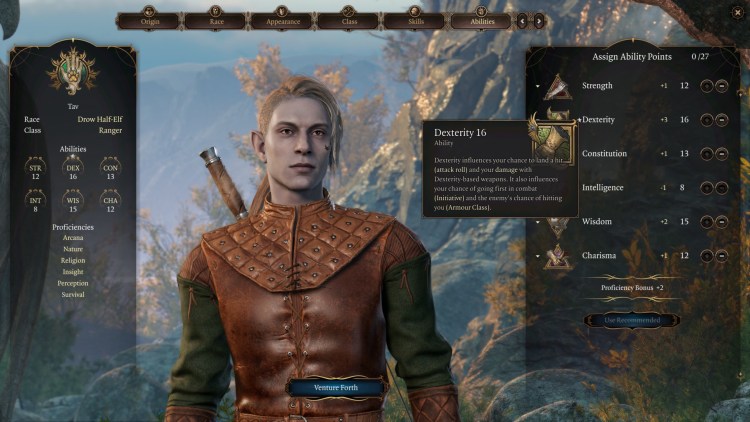
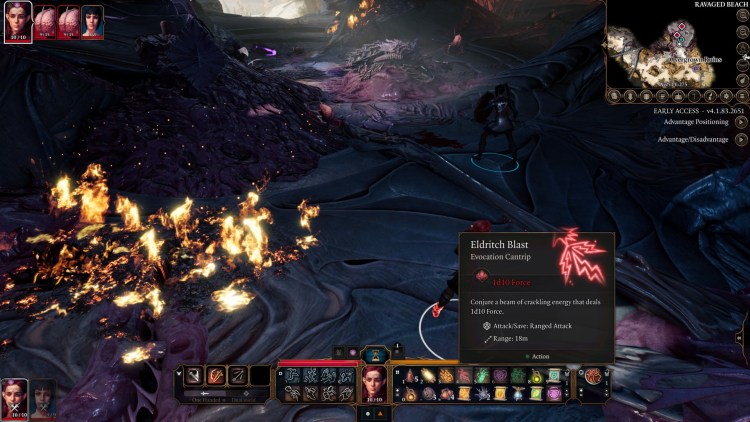
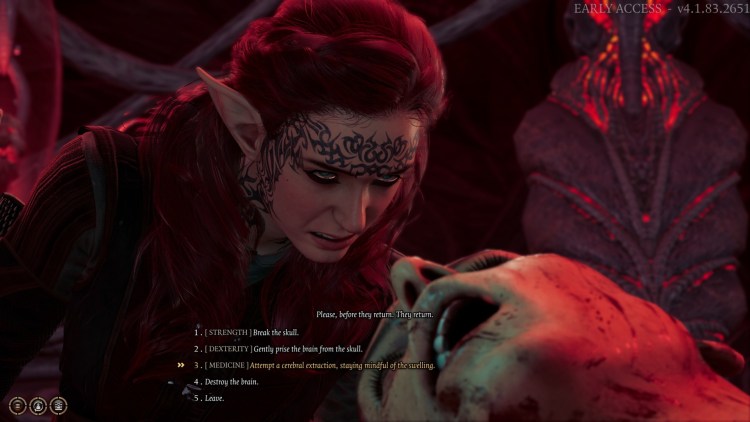
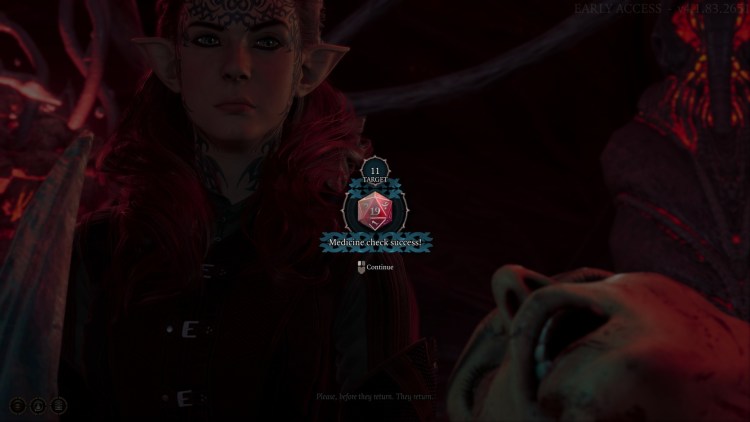
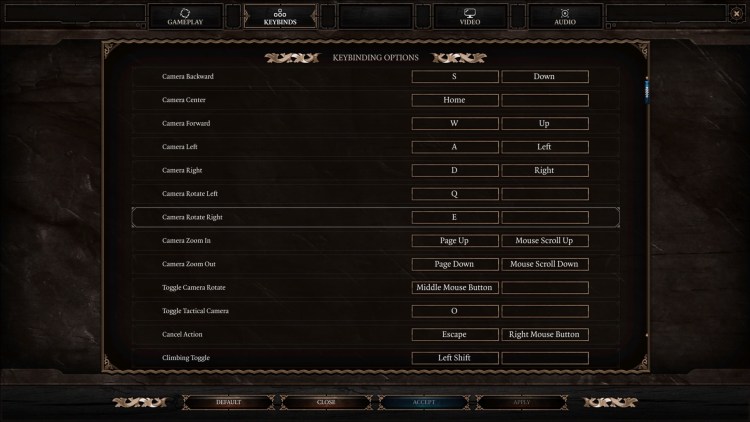
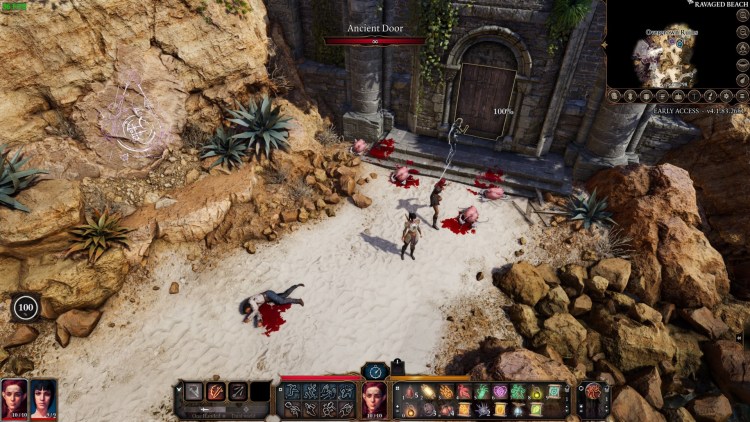
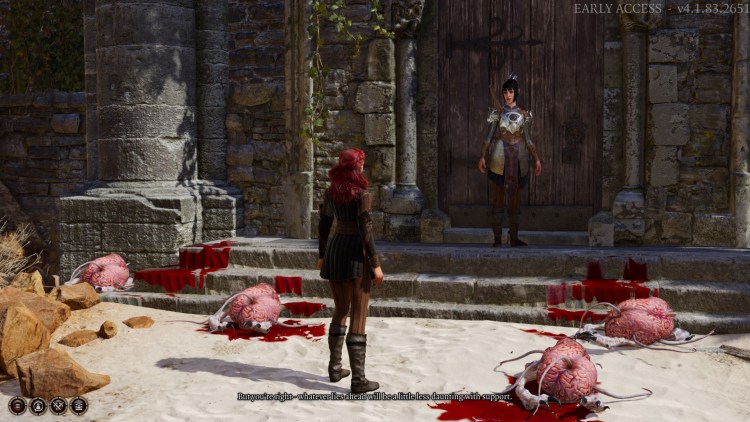
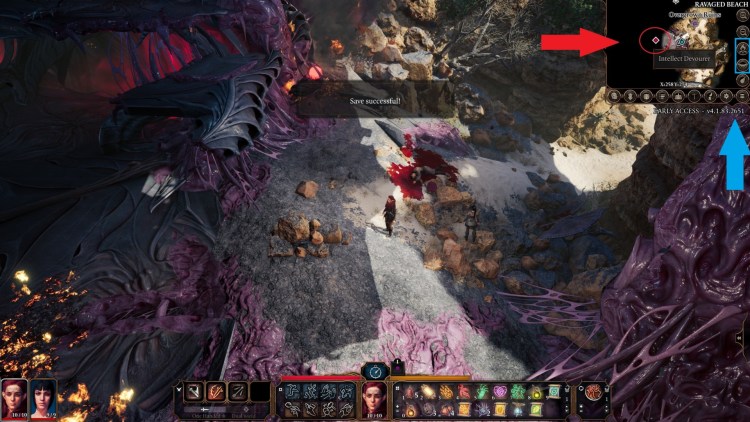




Published: Oct 7, 2020 11:35 PM UTC